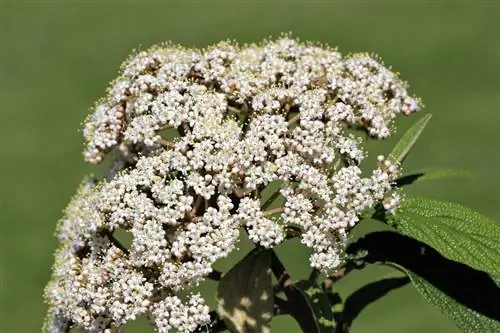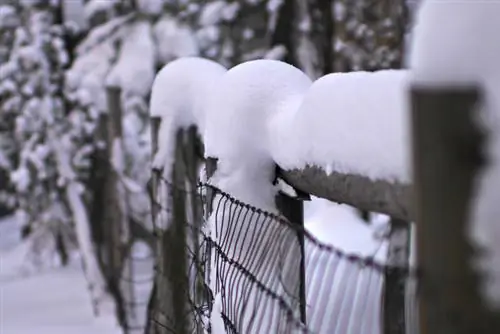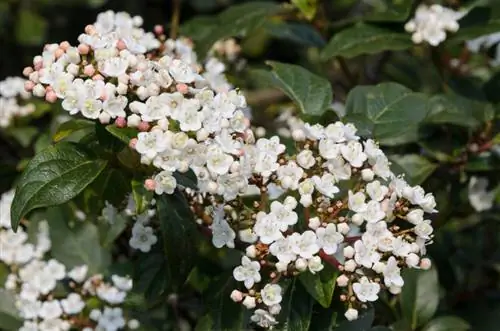- Author admin [email protected].
- Public 2023-12-16 16:46.
- Last modified 2025-01-23 11:20.
As an evergreen viburnum, Viburnum tinus is extremely decorative. At the same time, it can even grow in the shade and requires little care. But what does it look like in winter? Is this shrub hardy or does it need frost protection?

Is Viburnum tinus hardy?
Answer: Viburnum tinus is only partially hardy and can tolerate temperatures down to -5 °C. In milder locations it can overwinter outside; in severe frost, protective measures such as brushwood or fleece are necessary. The variety 'Exbury Form' is considered to be more frost hardy, but is not suitable for temperatures below -10 °C.
Poorly hardy
As soon as temperatures reach -5 °C, things get tight. Viburnum tinus has poor winter hardiness due to its native location in Mediterranean regions. In severe frosts, its shoots freeze and its evergreen leaves are soon shed. The shoots that are covered with flower buds and would bloom in March/April also freeze when temperatures fall below -5 °C.
Suitable for milder locations in outdoor cultivation
In wine-growing regions such as Rhineland-Palatinate, Viburnum tinus can remain outside throughout the winter. But it is urgently necessary to place the plant in a protected place or to select such a location when planting, for example on the wall of the house or under the protection of a wall or hedge. The location should be partially shaded and warm.
Winter in cooler regions of Germany
In most regions of Germany, this snowball would not survive the winter outside unprotected. Temperatures below -5 °C are typical in winter and are not uncommon. It is therefore advisable to protect Viburnum tinus in the root area using brushwood, leaves or compost. The shoots should also be wrapped with fleece (€34.00 on Amazon), jute or foil.
It is better to plant this plant in the pot straight away so that it can be put in in the fall and overwintered:
- choose a bright and frost-free place
- Temperatures between 5 and 10 °C are optimal
- water sparingly
- don't worry if evergreen leaves are shed
- put it out again from February (protect with fleece in case of frost)
After winter it's time to bloom
You shouldn't move your plant out of quarters or remove it from winter protection too late. As soon as the first days of spring begin, the flowering period begins. The flowers emit a strong scent and are sensitive to frost.
Tip
A variety of Viburnum tinus that is considered to be well frost hardy is 'Exbury Form'. But it is also not made for harsh locations and temperatures below -10 °C.






